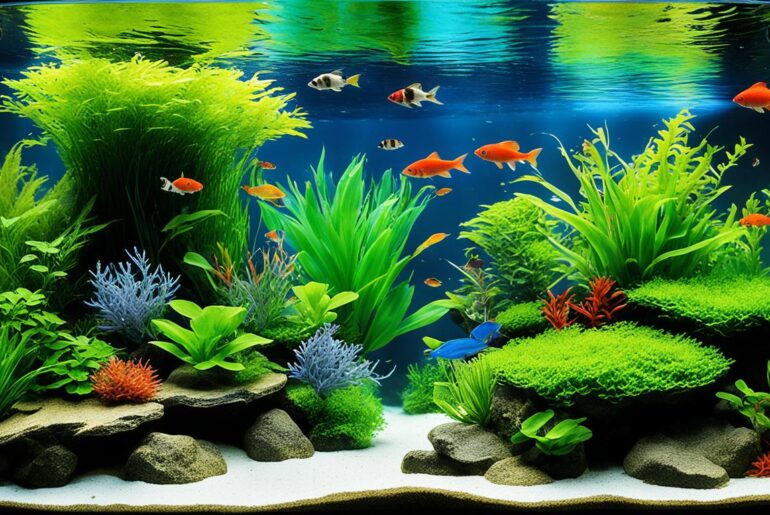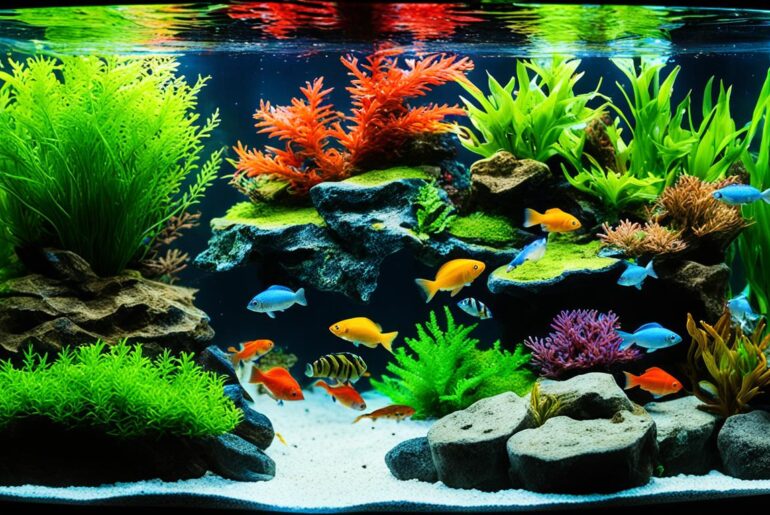Imagine the peaceful serenity of a freshwater aquarium, with vibrant fish gracefully swimming through crystal-clear waters. As an aquarium enthusiast, I have always been captivated by the beauty and tranquility of these underwater ecosystems. But I soon realized that creating and maintaining the perfect environment for my aquatic companions requires careful attention to detail.
From understanding the optimal water parameters to ensuring the right balance of essential elements, there is much to consider. But fear not, fellow aquarists! In this comprehensive guide, I will share my knowledge and experience to help you achieve the ideal water conditions for your freshwater aquarium, ensuring the health and well-being of your beloved fish.
Key Takeaways:
- Maintaining ideal water parameters is crucial for the health and well-being of fish in freshwater aquariums.
- Understanding pH, KH, and GH levels is essential for creating a stable and healthy environment.
- Regular testing, proper feeding, and regular maintenance are key to achieving and maintaining optimal water conditions.
- Partial water changes can help improve water quality and prevent issues in the aquarium.
Understanding pH in Freshwater Aquariums
pH plays a vital role in the health and well-being of fish in freshwater aquariums. It is a measure of the water’s acidity or alkalinity, which can influence the behavior, growth, and overall vitality of aquatic life. To ensure a thriving aquarium ecosystem, it is crucial to understand how to measure and maintain the ideal pH levels.
Most freshwater fish thrive in pH levels between 6.5 and 8.0. However, some species may have specific pH requirements. For instance, Amazonian fish species, such as the cardinal tetra, prefer slightly acidic water with a pH around 6.0-6.5, while African cichlids thrive in alkaline water with a pH of 7.8-8.5.
To measure the pH level in your aquarium, use a reliable test kit specifically designed for aquarium use. This kit will provide accurate readings, allowing you to monitor any fluctuations in pH over time. Regular testing is important because pH levels can change due to factors such as fish waste, decaying organic matter, or the addition of certain medications.
If the pH level deviates from the ideal range, adjustments can be made to correct it. For example, if the pH is too high, a pH reducer such as pH Down can be added to the aquarium gradually. Conversely, if the pH is too low, a pH increaser like pH Up can be used. However, it is crucial to make adjustments slowly and monitor the pH closely to avoid sudden pH swings that can stress or harm the fish.
It is worth noting that maintaining a stable pH level also depends on the buffering capacity of carbonate hardness (KH) in the water. KH helps stabilize pH by preventing sudden pH fluctuations. Regular testing of both pH and KH levels is essential to ensure a stable and healthy environment for your fish.
How to Measure pH in Aquariums:
- Choose a reliable aquarium test kit specifically designed to measure pH.
- Take a water sample from your aquarium following the instructions provided with the test kit.
- Add the test solution to the water sample as per the kit’s instructions.
- Compare the color or digital reading of the test solution to the pH scale provided in the test kit.
- Record the pH level and monitor any changes over time.
Regularly measuring and maintaining the ideal pH levels in your freshwater aquarium is essential for the health and well-being of your fish. By understanding the importance of pH and taking proactive steps to monitor and adjust it when necessary, you can create a thriving aquatic environment for your beloved fish.
Common Freshwater Fish and Their Ideal pH Ranges
| Fish Species | Ideal pH Range |
|---|---|
| Cardinal Tetra | 6.0-6.5 |
| Neon Tetra | 6.0-7.0 |
| Guppy | 6.8-7.8 |
| Danios | 6.0-7.0 |
| Angelfish | 6.5-7.8 |
Decoding KH in Freshwater Aquariums
In freshwater aquariums, KH, also known as carbonate hardness, plays a vital role in maintaining a stable pH level for the well-being of fish. It helps prevent sudden fluctuations in pH, creating a more favorable and consistent environment. By understanding and measuring KH levels, aquarists can ensure optimal water conditions for their aquarium inhabitants.
Measuring KH in aquariums is a straightforward process that requires a reliable test kit. These kits typically use color indicators to determine the amount of carbonate hardness in the water. By following the instructions provided with the kit, aquarists can obtain accurate KH measurements.
The ideal KH levels for most freshwater aquariums range between 4-8 dKH (degree carbonate hardness). This range provides the necessary stability to maintain a healthy pH level. However, it’s important to note that certain fish species may have specific KH requirements. It is recommended to research the specific needs of the fish species in your aquarium to ensure the ideal KH level.
To help illustrate the ideal KH levels for freshwater aquariums, refer to the following table:
| Fish Species | Ideal KH Level (dKH) |
|---|---|
| Tropical community fish | 4-8 dKH |
| African cichlids | 8-20 dKH |
| Amazonian fish | 1-4 dKH |
This table provides a general guideline for the ideal KH levels of different fish species commonly found in freshwater aquariums. It is important to note that individual fish species may have specific preferences, and it is always advisable to research their requirements before making any adjustments to KH levels.
Regular testing of KH levels is essential in maintaining a stable environment for fish. Gradual adjustments can be made using products like KH buffers or baking soda, but it’s important to monitor KH levels closely to avoid sudden changes that may stress the fish.

Unveiling GH in Freshwater Aquariums
In freshwater aquariums, GH, which stands for general hardness, refers to the concentration of calcium and magnesium ions in the water. This parameter plays a vital role in ensuring the overall health and development of fish, plants, and invertebrates in the aquarium ecosystem.
The ideal GH level for freshwater aquariums typically falls between 4-8 dGH. It is important to maintain this range to create a suitable environment for aquatic life to thrive. Deviations from the ideal GH levels can negatively impact the health and well-being of the aquarium inhabitants.
Measuring GH in aquariums is essential to monitor and regulate its levels. Periodic testing using a reliable test kit allows aquarists to keep a close eye on the GH values. By doing so, they can make necessary adjustments to maintain the optimal GH level within the recommended range.
Benefits of maintaining ideal GH levels in a freshwater aquarium:
- Promotes proper growth and development of fish, plants, and invertebrates
- Supports healthy bone and exoskeleton development
- Improves reproductive success of fish and invertebrates
Methods for Measuring GH
There are various methods available to measure GH in freshwater aquariums. One commonly used approach involves the use of test kits specifically designed for GH testing. These kits typically include chemical reagents and color charts that allow aquarists to interpret the results accurately.
When conducting a GH test, it is important to follow the instructions provided with the test kit carefully. This helps ensure accurate and reliable results. Aquarists should collect a water sample from the aquarium and add the test reagents according to the kit’s instructions. The resulting color change can be matched to the color chart provided to determine the GH level in the aquarium.
Regular testing and monitoring of GH levels enable aquarists to identify any fluctuations or deviations from the ideal range. In case the GH levels are outside the recommended range, appropriate actions can be taken to adjust the GH and bring it back to the desired level.
Regular testing using a reliable GH test kit is crucial for maintaining the ideal GH levels in a freshwater aquarium. By staying proactive and making necessary adjustments, aquarists can ensure a healthy and flourishing aquatic environment.
The Relationship Between pH, KH, and GH
When it comes to creating a stable and healthy environment for fish in your aquarium, understanding the relationship between pH, KH, and GH is crucial. These three parameters are closely interconnected and can have a significant impact on each other.
pH refers to the acidity or alkalinity of the water and plays a vital role in the overall health and behavior of fish. Most freshwater fish thrive in pH levels between 6.5 and 8.0. To maintain the optimal pH, it is important to regularly test the water using a reliable test kit and make adjustments if necessary.
KH, or carbonate hardness, acts as a buffer that helps stabilize the pH level in the aquarium. It prevents rapid fluctuations and provides a stable environment for fish. The ideal KH level for most freshwater aquariums is between 4 and 8 dKH. Testing and adjusting KH levels as needed is essential for maintaining a balanced pH.
GH, or general hardness, refers to the amount of calcium and magnesium ions in the water. It is essential for the overall health and development of fish, plants, and invertebrates. The ideal GH level for freshwater aquariums typically falls between 4 and 8 dGH. Regular testing and adjustments are necessary to ensure optimal GH levels.
It is important to note that pH, KH, and GH are closely intertwined. The buffering capacity of KH helps stabilize the pH, while GH provides essential minerals for fish and other aquatic life. Any changes made to one parameter can have an impact on the others. Therefore, when testing and adjusting these parameters, it is crucial to proceed cautiously and avoid sudden changes that can stress the fish.
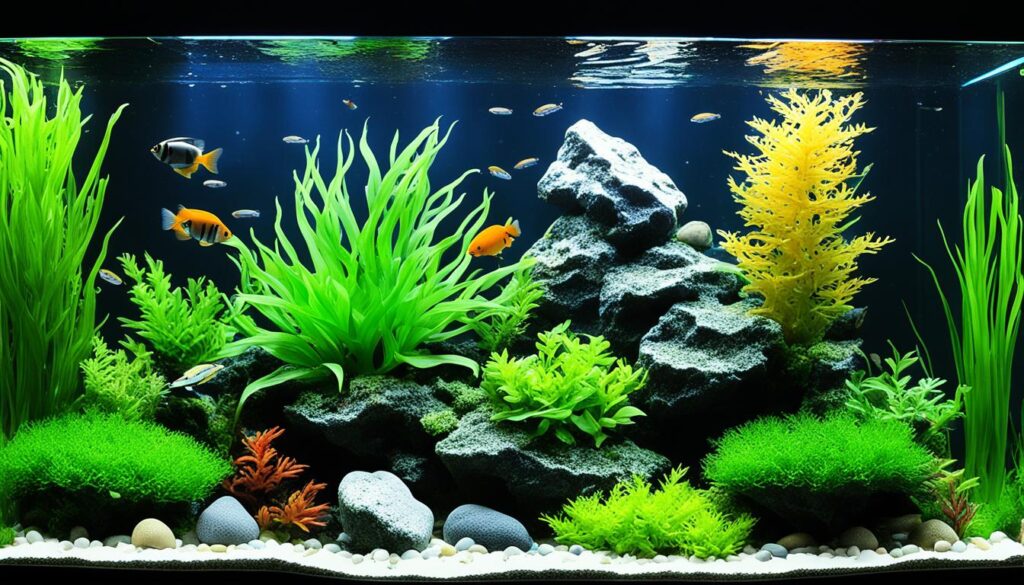
“Maintaining a balance between pH, KH, and GH is key to creating a stable and healthy environment for your aquarium inhabitants.”
Methods to Adjust pH, KH, and GH
When it comes to creating the ideal environment for your aquarium, adjusting the pH, KH, and GH levels plays a crucial role. Here, I will discuss various methods that you can use to raise or lower these parameters, ensuring optimal conditions for your aquatic pets.
Lowering pH and KH
If your aquarium’s pH and KH levels are higher than desired, gradually softening the water is the key. One effective method is to use reverse osmosis de-ionized (RODI) water. This type of water has low mineral content and is ideal for lowering both pH and KH levels in your aquarium.
Raising pH and KH
On the other hand, if your pH and KH levels are too low, you can raise them by adding crushed coral or other mineral additives to your aquarium. These substances act as natural buffers and gradually increase the pH and KH levels, ensuring a stable and healthy environment for your fish.
Remember, when adjusting pH, KH, and GH, it is important to make changes slowly and carefully. Rapid fluctuations can be stressful for fish and other aquatic inhabitants. Regularly monitor the water parameters using a reliable test kit and make adjustments as needed to maintain a stable and balanced environment.
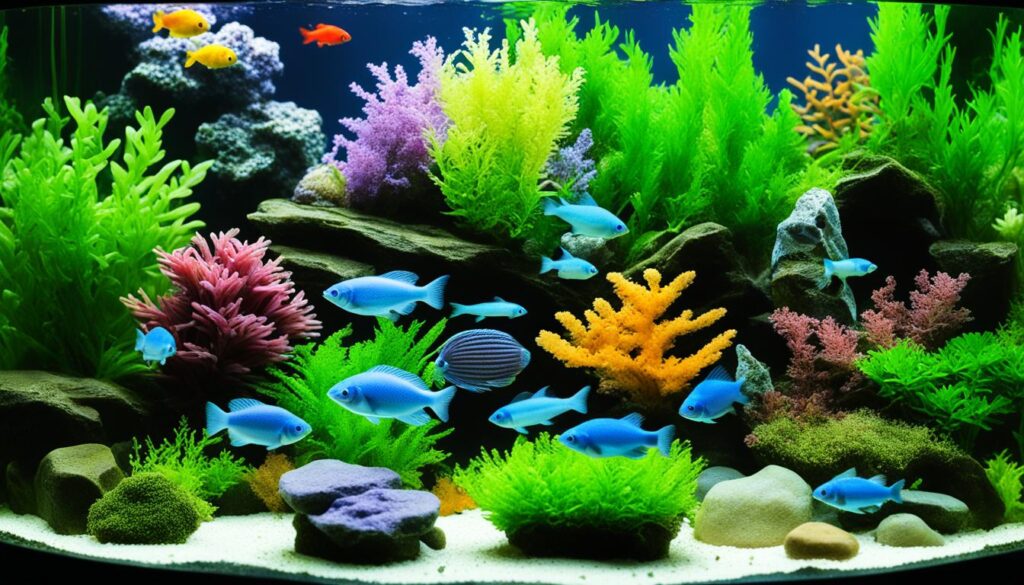
| Method | Effect |
|---|---|
| Using reverse osmosis de-ionized (RODI) water | Gradually lowers pH and KH |
| Adding crushed coral or mineral additives | Gradually raises pH and KH |
Importance of Purified Water and Proper Feeding
When it comes to maintaining a healthy aquarium, two critical factors often overlooked are the quality of the water and proper feeding practices. In this section, we’ll explore the significance of using purified water and the importance of feeding your aquatic pets the right way.
Purified Water for Aquariums
Purified water, such as reverse osmosis deionization (RODI) water, plays a vital role in creating and sustaining a suitable environment for your fish and other inhabitants. Using purified water helps eliminate contaminants that can be harmful to aquatic life and disrupt the delicate balance of your aquarium’s ecosystem.
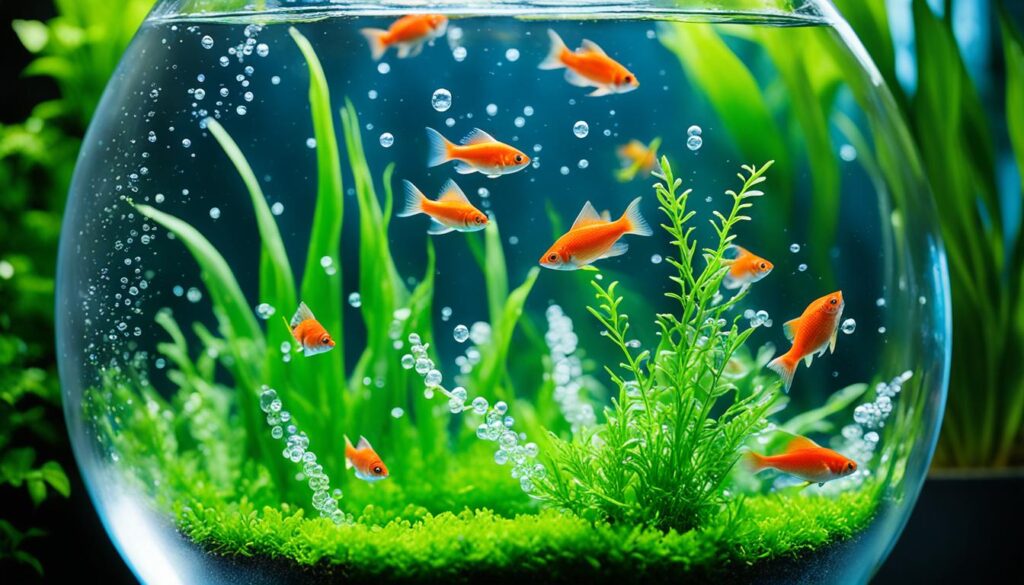
By removing impurities and chemicals from the water, you can maintain a stable and healthy water chemistry, which is crucial for the overall well-being of your aquarium’s inhabitants. The use of purified water also reduces the risk of water pollution and imbalances that can lead to stress and health issues in fish and other aquatic organisms.
Proper Feeding in Aquariums
Feeding your fish properly is essential for their growth, vitality, and overall health. Overfeeding is a common mistake that many aquarium owners make, often unintentionally. Excess food that remains uneaten can quickly deteriorate and pollute the water, compromising the water quality and endangering the health of your aquatic pets.
To avoid overfeeding, it’s crucial to feed your fish the appropriate amount of food that they can consume within a few minutes. Observing their eating habits and adjusting the portion size accordingly will help prevent the accumulation of uneaten food.
Remember, it’s better to slightly underfeed than to overfeed your fish. By practicing proper feeding techniques, you contribute to better water quality, reducing the risk of algae growth, bacterial outbreaks, and other related issues.
“Remember, it’s better to slightly underfeed than to overfeed your fish.”
In addition to proper feeding, maintaining a clean and efficient filtration system is equally important. Regularly cleaning and maintaining your filter will help remove excess food, debris, and waste, further promoting excellent water quality for your aquarium’s inhabitants.
By prioritizing purified water and practicing proper feeding and maintenance routines, you ensure a healthy and thriving aquatic environment. In the next section, we will delve into the significance of regular maintenance and water testing to uphold optimal water quality in your aquarium.
Regular Maintenance and Testing
As an aquarium owner, regular maintenance is essential to ensure the long-term health and well-being of your fish and other aquatic inhabitants. Consistent upkeep, including routine water changes and regular cleaning of mechanical and chemical filter media, plays a vital role in maintaining optimal water quality in your aquarium. By implementing a maintenance schedule and adhering to it consistently, you can prevent potential problems and create a thriving environment for your aquatic pets.
The Importance of Regular Water Changes
One crucial aspect of regular maintenance is performing routine water changes. Over time, toxins, excess nutrients, and waste products can accumulate in the water, posing a risk to the health of your fish. By conducting partial water changes on a regular basis, you can effectively remove these accumulated pollutants, improve water quality, and provide a clean and healthy environment for your fish to thrive.
During a water change, it is recommended to remove approximately 10-30% of the water from the aquarium. Be sure to use a dechlorinator or water conditioner when adding fresh water to neutralize harmful chlorine and chloramine, which can be present in tap water.
| Benefits of Regular Water Changes | How Often |
|---|---|
| Removes accumulated toxins and waste | Every 1-2 weeks |
| Reduces the risk of ammonia and nitrite spikes | Every 1-2 weeks |
| Improves overall water quality | Every 1-2 weeks |
| Helps maintain stable water parameters | Every 1-2 weeks |
| Prevents the buildup of excess nutrients | Every 1-2 weeks |
| Reduces the risk of algae outbreaks | Every 1-2 weeks |
Remember to constantly monitor the water parameters throughout the week to detect any significant fluctuations that may require more frequent water changes or additional adjustments.
The Importance of Water Testing in Aquariums
Testing the water parameters in your aquarium is an integral part of maintenance. By regularly checking the levels of ammonia, nitrite, nitrate, pH, and other essential parameters, you can gain valuable insights into the overall health of your aquarium and make necessary adjustments to ensure optimal conditions for your fish.
Choose a reliable water test kit that provides accurate and precise results. Follow the instructions carefully and test your water at least once a week, or more frequently if you notice any signs of stress or abnormal behavior in your fish. By regularly testing and monitoring the water parameters, you can promptly detect any issues and take immediate action to correct them before they become more severe.

Be sure to pay attention to the following key parameters during water testing:
- Ammonia: Ideally, ammonia levels should be at 0 ppm (parts per million).
- Nitrite: Nitrite levels should also be at 0 ppm.
- Nitrate: Aim for nitrate levels below 40 ppm.
- pH: Maintain the pH within the recommended range for your specific fish species.
Regular maintenance and water testing are the foundation of a healthy aquarium. By staying proactive and implementing a consistent maintenance routine, you can create a stable and thriving aquatic environment for your fish to flourish.
The Benefits of Partial Water Changes
Regular partial water changes offer numerous benefits for maintaining a healthy and thriving aquarium environment. Let’s explore the importance of these water changes and the advantages they provide.
1. Improved Water Quality
Partial water changes are an effective method for improving water quality in your aquarium. By removing accumulated waste, excess nutrients, and pollutants, partial water changes help create a cleaner and healthier environment for your fish. This reduces the risk of algae growth and promotes optimal fish health.
2. Prevention of Water Chemistry Imbalances
Through regular partial water changes, you can maintain a stable water chemistry in your aquarium. This helps prevent imbalances in pH, KH, and GH levels, which are crucial for the overall well-being of your fish and other aquatic inhabitants. By replenishing the water with fresh, clean water, you can ensure a more stable and suitable environment for your aquarium’s inhabitants.
3. Essential Mineral Replenishment
Partial water changes also provide an opportunity to replenish essential minerals in your aquarium. Over time, minerals that are beneficial for the health of your fish and plants may become depleted. By replacing a portion of the water with freshwater, you introduce new minerals into the system, promoting the overall vitality and growth of your aquarium’s inhabitants.
4. Disease Prevention
Regular water changes play a crucial role in preventing the onset and spread of diseases in your aquarium. By removing potentially harmful substances and pathogens, partial water changes help maintain a clean and disease-free environment. This promotes the well-being of your fish and reduces the likelihood of health issues or outbreaks.
Overall, the benefits of regular partial water changes cannot be overstated. They contribute to maintaining optimal water quality, preventing imbalances, replenishing essential minerals, and minimizing the risk of disease. By incorporating this simple yet effective maintenance practice into your aquarium care routine, you ensure a healthier and more vibrant aquatic ecosystem.

Implement regular partial water changes to enjoy a thriving and beautiful aquarium.
Conclusion
Maintaining water quality is paramount for the health and well-being of fish in freshwater aquariums. By understanding and closely monitoring pH, KH, and GH levels, using purified water, implementing proper feeding practices, and regularly testing and maintaining the aquarium, aquarists can achieve and sustain the ideal conditions for their aquatic companions.
By optimizing these factors, the aquarium becomes a thriving ecosystem for fish, plants, and other aquatic life. The water parameters directly impact the overall health and behavior of fish, ensuring their vitality and longevity. With the right combination of water parameters, fish are more likely to exhibit their natural colors, thrive in their environment, and exhibit vibrant and energetic behavior.
To maintain water quality, regular testing is essential. By using reliable test kits, aquarists can accurately assess water chemistry and make necessary adjustments. Additionally, practicing regular maintenance tasks, such as partial water changes and cleaning mechanical and chemical filtration media, helps remove accumulated waste and prevent the build-up of excess nutrients that can harm the aquarium ecosystem.
Ultimately, by maintaining the ideal water parameters and prioritizing water quality, aquarists create a captivating and healthy freshwater aquarium that brings joy and tranquility to their homes. With the right knowledge and dedication, aquarists can provide their fish with an environment that closely resembles their natural habitat, leading to thriving and flourishing aquatic life.
FAQ
Why are ideal water parameters important in a freshwater aquarium?
Maintaining ideal water parameters is crucial for the health and well-being of fish in freshwater aquariums. It creates a stable and healthy environment for fish, promoting their overall health and behavior.
What is pH, and why is it important in a freshwater aquarium?
pH is a measure of the acidity or alkalinity of water. Maintaining the appropriate pH level is important for the health and behavior of fish. Most freshwater fish thrive in pH levels between 6.5 and 8.0.
How do I measure and adjust pH in a freshwater aquarium?
You can measure the pH level using a reliable test kit. To adjust the pH, you can use reverse osmosis deionized (RODI) water to gradually soften the water. Adding crushed coral or other mineral additives can help raise pH levels.
What is KH, and why is it important in a freshwater aquarium?
KH, or carbonate hardness, plays a crucial role in stabilizing the pH level in an aquarium. It helps prevent rapid pH fluctuations and maintains a stable environment for fish.
How do I measure and adjust KH in a freshwater aquarium?
You can measure the KH level using a reliable test kit. To adjust the KH, you can use reverse osmosis deionized (RODI) water to gradually soften the water or add baking soda to increase KH levels.
What is GH, and why is it important in a freshwater aquarium?
GH, or general hardness, refers to the amount of calcium and magnesium ions in the water. It is essential for the overall health and development of fish, plants, and invertebrates in the aquarium.
How do I measure and adjust GH in a freshwater aquarium?
You can measure the GH level using a reliable test kit. To adjust the GH, you can use mineral additives or adjust the water source to increase or decrease the GH levels.
pH, KH, and GH are closely related and can impact each other in the aquarium. Maintaining the appropriate balance between these parameters is essential for creating a stable and healthy environment for fish.
How do I adjust pH, KH, and GH levels in a freshwater aquarium?
To adjust pH and KH levels, you can use reverse osmosis deionized (RODI) water to gradually soften the water or add mineral additives to raise pH and KH levels. Adjusting GH can be done by using mineral additives or adjusting the water source.
Why is purified water important in a freshwater aquarium, and how do I ensure proper feeding?
Using purified water, such as reverse osmosis deionization (RODI) water, helps eliminate contaminants and maintain stable water chemistry. Proper feeding practices, such as avoiding overfeeding, contribute to better water quality.
How do I maintain regular maintenance and testing in a freshwater aquarium?
Consistent maintenance, including regular water changes and cleaning of mechanical and chemical filter media, is essential for maintaining optimal water quality. Testing the water parameters using reliable test kits is important to monitor and make necessary adjustments.
Why are partial water changes beneficial, and how often should I perform them?
Partial water changes help remove accumulated waste, excess nutrients, and pollutants, reducing the risk of algae growth and maintaining a healthy environment. Regular partial water changes also replenish essential minerals and maintain a stable water chemistry. It is recommended to perform partial water changes every 1-2 weeks.
How do I maintain the ideal water parameters in a freshwater aquarium?
By understanding and carefully monitoring pH, KH, and GH levels, using purified water, practicing proper feeding, and regularly testing and maintaining the aquarium, aquarists can achieve and maintain optimal water conditions, leading to thriving fish, plants, and other aquatic life in the aquarium.


